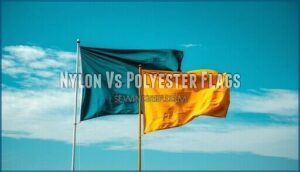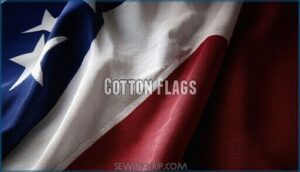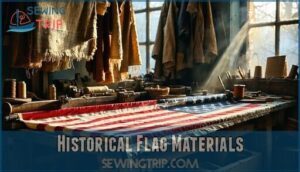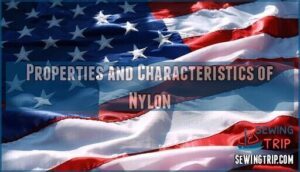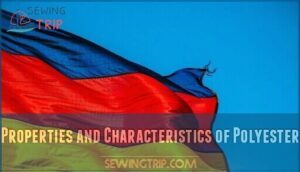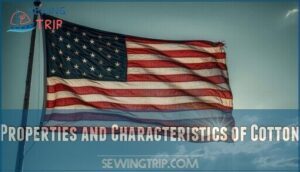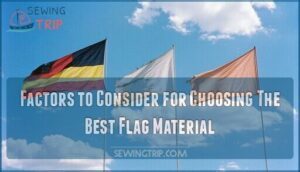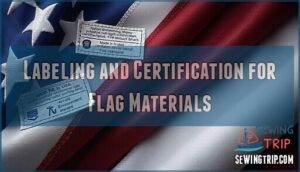This site is supported by our readers. We may earn a commission, at no cost to you, if you purchase through links.
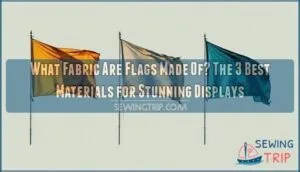 Flags are usually made of nylon, polyester, or cotton, with each fabric serving a distinct purpose.
Flags are usually made of nylon, polyester, or cotton, with each fabric serving a distinct purpose.
Nylon is lightweight, resists water, and keeps its colors bold, making it perfect for outdoor use.
Polyester is heavy-duty and handles harsh winds and sunlight, so it’s great for long-term displays.
Cotton, often used for ceremonial or historical flags, adds a traditional touch with its natural look but isn’t the best for weather resistance.
Choosing the right fabric depends on where and how you’ll use the flag, it’s like picking the right outfit—function first, style second.
Materials matter, especially when your flag tells a story.
Table Of Contents
- Key Takeaways
- Types of Flags and Their Construction
- Common Flag Materials
- Historical Flag Materials
- Properties and Characteristics of Nylon
- Properties and Characteristics of Polyester
- Properties and Characteristics of Cotton
- Factors to Consider for Choosing The Best Flag Material
- Labeling and Certification for Flag Materials
- Frequently Asked Questions (FAQs)
- Conclusion
Key Takeaways
- You’ll find most flags are made from three primary materials: nylon (lightweight and colorful for regular outdoor use), polyester (heavy-duty for harsh weather), and cotton (traditional look for indoor and ceremonial displays).
- Your outdoor flag’s durability depends on the material you choose—polyester withstands high winds and constant exposure better than nylon, though nylon offers excellent UV resistance and flies well in light breezes.
- When selecting a flag, consider where you’ll display it—indoor flags benefit from cotton‘s elegant drape and rich appearance, while outdoor flags need weather-resistant synthetic fabrics with reinforced stitching.
- You can identify quality flags by checking for proper labeling, country of origin information, and certifications like "Made in USA," which indicate compliance with material standards and ethical sourcing practices.
Types of Flags and Their Construction
Flags come in two main construction methods: printed and fully sewn.
Printed flags apply designs directly onto fabric, while fully sewn flags stitch multiple pieces together for a traditional look.
Flag materials vary based on intended use, with synthetic fabrics dominating modern production.
Most quality flags use lock stitching for durability, creating secure seams that withstand wind stress.
When selecting a flag, consider the flagpole attachment styles—sleeve, grommets, or rope ties—that best suit your display needs.
Standard flag size standards follow specific width-to-length ratios, ensuring proper proportions whether you’re displaying indoors or facing outdoor elements, using traditional look and secure seams for a lasting impression.
Common Flag Materials
You’ll find most modern flags are made from three main materials: nylon, polyester, and cotton.
Each fabric offers specific benefits for different display conditions, with nylon providing lightweight durability, polyester offering superior weather resistance, and cotton delivering a classic appearance for indoor use, including superior weather resistance from polyester.
Nylon Vs Polyester Flags
When choosing between nylon and polyester flags, understanding their key differences helps you make the right choice for your display needs.
Nylon flags offer a lightweight appearance with vibrant colors that fly well in light winds.
They’re more affordable and have excellent drapability, making them suitable for both indoor and outdoor use.
They dry quickly after rain.
Polyester flags provide superior durability in harsh conditions.
Their heavier construction withstands high winds better and extends their lifespan.
While slightly more expensive and less flowing, polyester is the better choice for 24/7 outdoor displays or high-wind areas.
You can find a wide selection online for both types of flags, allowing you to choose the best option based on your specific needs and preferences for outdoor use or indoor display.
Cotton Flags
The classic appeal of cotton flags connects us to tradition while offering unique benefits for specific display settings.
Timeless cotton flags embody tradition and elegance, making them perfect for ceremonial displays and honoring meaningful moments.
Cotton flag fabric features a tight weave that creates rich, deep colors and a substantial feel in your hands.
Unlike synthetic flag materials, cotton provides excellent indoor performance with its natural drape and elegant appearance, making it ideal for ceremonial settings and interior displays.
Cotton durability isn’t suited for outdoor conditions, as weather exposure leads to significant fading issues over time.
You’ll find cotton flags require more maintenance, with special attention needed when cleaning cotton items to prevent shrinkage or color bleeding.
For indoor use, cotton remains a premium choice, though cotton alternatives like polyester blends offer similar aesthetics with improved longevity.
When displaying cotton flags, keep them away from direct sunlight and moisture to prevent deterioration.
The natural fibers in cotton flag material create a distinctive texture that synthetic options simply can’t match—perfect for those who value authenticity over weather resistance.
Historical Flag Materials
Throughout history, flag makers relied on natural materials before synthetic options existed.
Historical flag materials included:
- Silk – prized for its elegant movement but limited by high silk cost
- Wool – valued for wool durability in damp conditions
- Linen – appreciated for distinctive linen texture and strength
- Hemp versatility – offered robustness for maritime flags
- Cotton flag fabric – provided accessibility and reasonable longevity
Early American flags often featured wool or linen, with silk reserved for ceremonial purposes. Each flag fabric type offered unique benefits, though all required more maintenance than modern materials.
Hemp was particularly common for naval flags thanks to its resistance to sea spray. Cotton flags, however, are known for their traditional and elegant look, which can be described as traditional and elegant.
The use of these materials was significant because they each had unique benefits and drawbacks, making them suitable for different purposes.
Properties and Characteristics of Nylon
Nylon stands out as the most popular flag fabric for good reason.
This lightweight material offers excellent durability while remaining cost-effective.
When crafted into flag material, nylon’s unique properties shine – it’s naturally UV resistant, helping your flags maintain vibrant colors even after months of sun exposure.
Different nylon weaves affect flag durability, with 200-denier being standard for most outdoor displays.
You’ll appreciate how nylon flag fabric dries quickly after rain and resists fraying better than natural alternatives.
Its lightweight nature allows flags to catch even gentle breezes, creating that perfect, patriotic wave you’re looking for.
Properties and Characteristics of Polyester
Polyester flag fabric is a standout choice for its durability and weather resistance.
Its tensile strength and fray resistance keep flags intact, even under strong winds.
Designed to endure, polyester flags resist fading caused by sun exposure and harsh weather, making them fade-resistant.
Lightweight but tough, they maintain vibrant color retention season after season.
For added flag durability, 2-ply polyester boosts strength with double-layered construction.
These flag fabric properties guarantee long-lasting performance, whether flying high in storms or basking in the summer sun, ensuring long-lasting results.
Properties and Characteristics of Cotton
Cotton is a natural fiber known for its classic look and soft texture, making it a popular choice for indoor flags.
However, it’s less durable outdoors as it fades, absorbs moisture, and can mildew over time.
The Majesty of Cotton Flags
Cotton flags bring a timeless charm with their natural, breathable texture and superior drape.
Ideal for indoor aesthetics, they exude elegance in formal settings like military ceremonies or government halls.
While cotton offers durability for light use, its weave is better suited indoors as outdoor exposure may lead to cotton fading.
Historically significant, this flag fabric stands out for its soft feel and vibrant appearance, even after washes, making it a cherished choice for thoughtful displays.
Ceremonial Flag Fabric
You’ll find that ceremonial flags often rely on cotton for their classic charm and meaningful presence.
This flag material stands out for its soft drape, allowing it to flow gracefully during formal presentations or indoor displays.
The breathability of cotton adds to its appeal, ensuring it doesn’t feel heavy or stiff when handled.
With its ability to retain vibrant colors through advanced dyeing techniques, cotton delivers an impressive range of fabric symbolism, representing tradition and dignity.
Enhancements like fringe options and embellishment styles, such as embroidered emblems or gold accents, add a touch of sophistication.
Proper preservation methods, like storing cotton flags in dry areas, help maintain their pristine look over time.
While silk exudes luxury, cotton provides durable elegance at a lower cost, making it a top choice for ceremonial occasions.
A cotton flag’s timeless air of respect reflects the tradition you wish to honor.
You can even find cotton ceremonial flags for purchase online.
Factors to Consider for Choosing The Best Flag Material
Choosing the right flag material depends on where and how you’ll use it.
Factors like weather resistance, durability, and cost play a big role in ensuring your flag looks great and lasts.
Outdoor Flag Considerations
When picking the best flag material for outdoor use, focus on weather durability and wind resistance. You’ll want a durable flag fabric like nylon or polyester, as both resist UV exposure and maintain color vibrancy better than most.
For areas with high winds, heavier polyester is ideal, while lightweight nylon works well in gentle breezes. Weather-resistant flags often include reinforced stitching, like lock stitching, which prevents fraying and increases lifespan.
You may want to explore options for flag material to find the best fit. Look for outdoor flag fabric treated with UV protection to minimize color fading from sunlight.
Also, consider the design—print-friendly materials guarantee crisp, lasting visuals despite harsh conditions. Always stick to flag material that meets standards like the US Textile and Wool Act for reliable quality in outdoor displays.
Indoor Flag Considerations
When choosing indoor flags, focus on the fabric’s durability and appearance for long-term elegance.
Here’s a quick guide:
- Indoor Lighting: Pick flag fabric types that complement your display area’s brightness and enhance aesthetics.
- Display Methods: Make certain the flag material allows easy mounting without creases or sagging.
- Fabric Care: Cotton looks classy indoors but needs gentle cleaning.
- Storage Solutions: Store flat or rolled to avoid permanent folds.
- Certification: Check for quality certifications ensuring trusted flag fabric blends.
Thoughtful fabric choices make all the difference! For longevity, consider fabrics with high denier flag density.
Labeling and Certification for Flag Materials
When selecting flag fabric, verifying authenticity and ensuring proper material origin labels are key.
U.S. law requires outdoor flags to display the country of origin, manufacturer details, and fabric content. Look for certifications like “Made in the USA” for ethical sourcing and compliance.
Durability certifications, including fire-retardant treatments, boost flag longevity under harsh conditions. Nylon is lightweight but less tough than polyester, while hybrid blends balance durability and elegance.
Prioritize environmental standards when finalizing fabric choice for reliable, quality flags. You can also perform a fabric burn test to identify the fiber content.
Frequently Asked Questions (FAQs)
What materials are used to make flags?
Modern flags are typically made from nylon, polyester, and cotton. You’ll find nylon is lightweight and economical, polyester offers durability for extreme conditions, and cotton works best for indoor displays.
What type of fabric is the American flag made of?
The American flag is typically made of nylon or polyester.
You’ll find nylon flags are lightweight and fly easily in slight breezes, while polyester ones offer better durability for continuous outdoor display.
What is a flag typically made of?
Flags frequently feature fabrics like nylon, polyester, and cotton.
You’ll find nylon flags are lightweight and colorful, polyester flags offer durability for outdoor use, and cotton flags typically serve indoor purposes, with durability being a key factor in the choice of flag material.
What are the most common flag materials?
The most common materials for flags are nylon, polyester, and cotton. You’ll find nylon used most often for its lightweight properties and durability, while polyester excels in extreme weather conditions.
What are the different types of flag materials?
You’ll find most flags are made from nylon, polyester, or cotton. Nylon is lightweight and economical, polyester offers durability for harsh conditions, and cotton works best for indoor displays.
What is the best fabric for US flags?
Like a sailor weathering a storm, you’ll find polyester and nylon reign supreme for US flags.
Polyester offers durability in high winds, while nylon provides excellent UV resistance at a lower cost.
What type of fabric is used for flags?
Modern flags are typically made of nylon, polyester, or cotton. You’ll find nylon is lightweight and economical, polyester offers durability for extreme conditions, while cotton works best for indoor displays.
What material are most American flags made of?
Waving proudly in American skies, most U.S. flags you’ll see today are made of nylon or polyester.
Nylon is lightweight and affordable, while polyester offers extra durability for harsh weather conditions.
What material is the flag made of?
Flags today are primarily made from three materials: nylon, polyester, and cotton.
Nylon is lightweight and most popular. Polyester offers greater durability for harsh conditions.
Polyester is used for outdoor flags, while cotton is typically used for indoor displays.
What is the most common material used for outdoor flags?
Just as sailors trust nylon for sails in rough seas, you’ll find nylon is the most common material for outdoor flags.
It’s lightweight, UV-resistant, and affordable compared to polyester or cotton alternatives.
Conclusion
Selecting what fabric are flags made of doesn’t need to be complicated.
Whether you choose lightweight nylon for vibrant outdoor displays, durable polyester for challenging weather conditions, or traditional cotton for ceremonial purposes, your choice should match your specific needs.
Consider your display location, weather exposure, and intended purpose.
Each material offers unique benefits—nylon for color brilliance, polyester for longevity, and cotton for authenticity.
You’ll find the perfect flag fabric by prioritizing function without sacrificing visual impact.

